 Ratko Mladic – who is a.k.a. as ‘the Butcher of Bosnia’ – is the former Chief of Staff of the Army of the Republika Srpska (the Bosnian Serb Army) during the Bosnian War 1992–1995.
Ratko Mladic – who is a.k.a. as ‘the Butcher of Bosnia’ – is the former Chief of Staff of the Army of the Republika Srpska (the Bosnian Serb Army) during the Bosnian War 1992–1995.
In 1995, he was indicted by the International Criminal Tribunal for the former Yugoslavia (ICTY) for genocide, war crimes and crimes against humanity. He was a fugitive until he was arrested by Serbian security forces on May 26, 2011 in Lazarevo, Serbia.
MANY MORE PHOTO GALLERY & HAND STORIES ARE AVAILABLE HERE:
http://www.handresearch.com/hands-of-fame.htm




















Ratko Mladic after his arrest in may 2011:

Ratko Mladic at the Bosnia Tribunal, The Hague - may 2011.
The hand in Marfan syndrome: thin fingers, hand signs, hypermobility, skin quality & more!
May 24, 2011

Marfan syndrome can be understood as a connective tissue disorder – which relates to the tissue that strengthens the body. The syndrome is usually featured with a tall, slender body with long limbs & extremely long, thin fingers & toes. The most serious complications are the defects of the heart valves and the aorta, which could lead to an aortic rupture (due to too much stress on the aorta), which is usually fatal. But many people who have this disorder are not aware of it! This is partly because Marfan syndrome typically becomes manifest only after the age of 5. But there are many hand signs that have a highly reliable diagnostic value!
Marfan syndrome is featured with many typical hand characteristics, however a combination of two specific hands signs related to a long hand shape (hand signs) & hand motorics (joint hypermobility) is often enough to identify the disorder.
THE STEINBERG SIGN (a):
This test is used for the clinical evaluation of Marfan patients.
Procedure:
Instruct the patient to fold his thumb into the closed fist. This test is positive if the thumb tip extends from palm of hand (see figure a).
THE WALKER-MURDOCH SIGN (b):
This test is used for the evaluation of patients with Marfan syndrome.
Procedure:
Instruct the patient to grip his wrist with his opposite hand. If thumb and fifth finger of the hand overlap with each other, this represents a positive Walker-Murdoch sign (see figure b).

JOINT HYPERMOBILITY
How to check if a person has hypermobility? You can check this easily by doing the 5 tests that are included in the so-called ‘Beighton score‘: see figure 1.
A ‘Beighton score’ of 4 or above usually indicates hypermobility.
And if a person has the Sternberg sign + Walker-Murdoch sign + hypermobility, the chances are above 90% that the person has Marfan syndrome.
The presence of other related hand markers such as: skin quality (hyperextensiblity), a simian crease, extra digital transverse creases, or a high positioned axial triradius provide other significant hand signs which are indicative for a person to have a medical test for Marfan syndrome.

A typical 'Marfan' hand gesture!
‘IN MY HANDS’ – A Marfan syndrome documentary!
May 18, 2011
What did Abraham Lincoln and Johnathan Larson, the playwright of the musical “Rent,” have in common? They both had Marfan Syndrome, according to a new documentary movie that will be screened at the film festival this weekend.
“In My Hands” eloquently explores the lives of a few of the more than 200,000 people in the US stricken with Marfan Syndrome – a little known genetic connective tissue condition that, prior to the invention of open heart surgery in the 1950’s, usually meant a death sentence – and the people who love them.
Dancer and choreographer Ann Reinking, whose son Chris is affected with Marfan syndrome, works with a group of teenagers, designing movement and dance that capitalizes on their shaky long bodies, and unexpectedly, inspires their self-esteem.
 Many syndromes & diseases are features with unusual hand characteristics. Long & hypermobile hands is one of the common characteristics of Marfan Syndrome. Learn a little bit more about Marfan syndrome via this quiz about hand motorics.
Many syndromes & diseases are features with unusual hand characteristics. Long & hypermobile hands is one of the common characteristics of Marfan Syndrome. Learn a little bit more about Marfan syndrome via this quiz about hand motorics.
HANDS & DOWN SYNDROME – A Simian Crease Poll!
May 15, 2011

The BabyCenter.com has conducted a simian crease poll among parents of children who have Down syndrome.
The result confirms the significance of the simian line in Down syndrome, because 41 of the 95 participants (=43%) reported that their child has Down’s syndrome.
But the diagnostic signficance of a simian crease (simian line) is unspecific. Despite the fact that the simian crease is well-known for it’s significance in children & adults who have Down syndrome – there are quite a few other syndromes which show even higher percentages regarding the occurence of the simian crease, such as: the cat-cry syndrome, Edwards syndrome, Patau syndrome, and Cornelia de Lange syndrome.
The most common synonyms for the simian crease are: simian line, single transverse crease, single palmar crease
Read more about the role of the simian crease in Multi-Perspective Palm Reading:
http://www.multiperspectivepalmreading.com/palm-reading-hand-creases-major-lines.htm
Hand shape varies between the two sexes: males typically have larger, relatively broader hands, while females typically have smaller, relatively narrower hands. But hand shape also varies among the various populations around the world: in Asia the avarage hand shape is relatively narrower than in European & North American countries. And there is even a link between hand shape & intelligence!
But in order to understand these patterns properly, one first has to understand the relations ship between hand shape & body length. Because in general, all longer populations in the world (males, Europeans & North Americans) typically display a relatively broad hand shape, while all small populations (females, Asians) typically display a relatively narrow hand shape.
–
HAND INDEX:

A good measure to describe the shape of the hand is the so-called ‘hand index’, which is defined as the ratio between the ‘hand width’ (= palm width measured at the metacapals) vs. the ‘hand length’ (= the distance between the tip of the middle finger and the distal wrist crease).
The average ‘hand index’ in human kind is close to 0.44, and is typically much higher than the ‘hand index’ seen in primates, which is typically (far) below 0.40 (though in gorillas – the largest of all primate species – the ‘hand index’ is higher than 0.40).
NOTICE: Finger length can also be measured relative to ‘hand length’ & ‘hand width’, but that topic will be discussed later.
–

HAND SHAPE & SEXE:
In males the ‘hand index’ is typically higher than 0.44, and measures above 0.45 are often seen. While in females the ‘hand index’ is typically lower than 0.44, and measures below 0.43 are not rare at all. These sexe differences are for a large part the result of the body height differences between males and females.
HAND SHAPE & RACE:
The average ‘hand index’ among the various races differs significantly, and is typically lower among asians. In people from China does not vary a lot from the average of human kind, but among for example people from Japan & India the ‘hand index’ is typically close to 0.43 or even lower. At least partly these differences are explained by racial differences in body height.
HAND SHAPE & IQ:
A high hand index typically correlates with a low IQ. And this link between hand shape & IQ has been confirmed in quite a few studies among various types of populations.
In a 1980 study in the former Yugoslavia reported among 540 men a negative correlation between hand index & all 10 measures for IQ.
And the two most common causes for mental retardation (Down syndrome & fragile-X syndrome) are known for having typically a relatively broad hand (= high hand index).
Regarding the sexe differences, one has to be aware of the earlier mentioned point that tall populations typically have a higher ‘hand index’. The fact that women have a lower ‘hand index’ compared to men, is largely neutralized by the fact that women are smaller than men. And therefore there one should not associate this sexe difference with IQ differences among the sexes (because so far there is no evidence for that at all).
And finally there is evidence that when the ‘hand index’ is corrected for body height, then this appears to explain a significant part of the IQ differences that are typically seen between the nations of the world. Though this issue has not been studied thoroughly.
HIGH OR LOW ‘HAND INDEX’ IN INDIVUALS:
The above describes patterns for hand shape implicate that regarding the implications of a high or low ‘hand index’ indivuals, one always has to consider sexe & race before jumping into conclusions!
Time for a hand shape palm reading… what is your ‘hand index’?

 Dr. Nosanchuk, Associate Professor of Medicine (Division of Infectious Diseases) and Microbiology/Immunology at the Albert Einstein College of Medicine, Bronx, New York, considers the fact that while healthcare workers know that they should wash their hands, nosocomial infections associated with the transmission of microbes from health care workers to patients remains an enormous problem:
Dr. Nosanchuk, Associate Professor of Medicine (Division of Infectious Diseases) and Microbiology/Immunology at the Albert Einstein College of Medicine, Bronx, New York, considers the fact that while healthcare workers know that they should wash their hands, nosocomial infections associated with the transmission of microbes from health care workers to patients remains an enormous problem:
“We know from various studies as well as observing our fellow clinicians on the wards that hand washing rates dramatically improve when clinicians are observed in the course of routine healthcare delivery. What I didn’t know was that electronic systems that can detect alcohol present in microbicidal gels and soaps. From a pubmed search, I learned that these systems have been in development for several years!”
“The systems available vary, but basically you wear an indicator that, for example, blinks when you wash your hands at a monitored sink. The system registers that you applied a gel or soap. If you approach a patient while wearing the badge without washing your hands at the appropriate sink, the badge vibrates to remind you to return to the hand washing area. If you fail to wash your hands despite the warning, you are flagged (but not directly flogged!) by the system.”
Full article is available at:
http://boards.medscape.com/forums?128@@.2a0928da
More articles about hand hygiene:
http://www.handresearch.com/news/hands-on-hand-hygiene.htm


What discriminates ‘Multi-Perspective Palm Reading’ from all other approaches in the field of hand reading?
Multi-Perspective Palm Reading is a new type of hand reading that is rising from scientific research reports that relate to the hand as a ‘diagnostic tool’. The unique characteristic of this advanced type of palm reading is that it only includes hand markers which have been confirmed to have significant value according scientific studies. So this NEXT NATURE variant of ‘palmistry’ is not connected anyhow with astrology nor any other philosophic system.
In Multi-Perspective Palm Reading is the hand studied from 7 different perspectives in order to make an assessment for various specified themes – which can result in either a confirming- or prognostic ‘hand-diagnosis’.
The philosophy behind Multi-Perspective Palm Reading:
The philosophy behind this new advanced type of hand reading can be described as follows:
“In Multi-Perspective Palm Reading, a reliable hand-diagnosis is only possible when a pair of hands displays ‘diagnostic clues’ in MULTIPLE perspectives of the hand. According Multi-Perspective Palm Reading a person typically requires to have ‘diagnostic clues’ in at least 3 perspectives of his/her hands, before one can speak of a solid, specified hand-diagnosis.
The application of this philosophy in the practice for making a hand assessment can be understood by studying the role of the simian line in hand diagnostics. In the 20th century the simian line (the most well known of all palm line variations: a.k.a. the single palmar transverse crease or simian crease) became known as a diagnostic marker for Down syndrome. However, during the past decades this uncommon hand marker was recognized as a ‘minor physical anomaly’ that has diagnostic value for other syndromes, diseases & developmental problems. But in order to specify it’s significance as a major hand line for the individual that has this characteristic in one or both hands, a study of the other perspectives of the hand is required!
The 7 perspectives used in Multi-Perspective Palm Reading:
In the following seven perspectives are required to be studied in order to make a thorough hand assessment:
1 – Palm Reading & the HAND SHAPE, including e.g.: hand index, palm shape, hand length, hand breath.
2 – Palm Reading & the FINGERNAILS, including e.g.: color, morphology, structure, growth.
3 – Palm Reading & FINGER MORPHOLOGY, including e.g.: finger length, 2D:4D ratio, variations in shape & width.
4 – Palm Reading & the MAJOR LINES, including e.g.: primary creases, secundary creases, tertairy creases & accessory lines.
5 – Palm Reading & the DERMATOGLYPHICS, including e.g.: fingerprints, palmar dermatoglyphics.
6 – Palm Reading & SKIN QUALITY, including e.g.: colour, structure, flexure / tone.
7 – Palm Reading & HAND MOTORICS, including e.g.: flexibility, motoric hand index.
Read more about how Multi-Perspective Palm Reading varies from other types of hand reading & modern palmistry via the Wikipedia section: Modern Palmistry: science & criticism





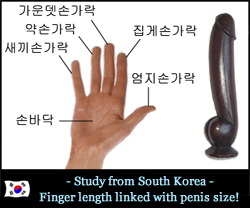 Finger length & penis size linked!
Finger length & penis size linked!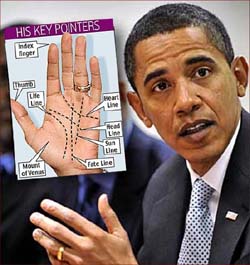 The hands of Barack Obama
The hands of Barack Obama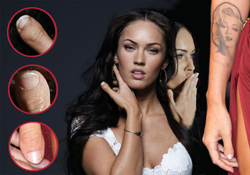 Megan Fox thumbs – TRIBUTE
Megan Fox thumbs – TRIBUTE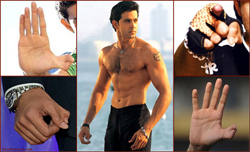 Hrithik Roshan thumbs – TRIBUTE
Hrithik Roshan thumbs – TRIBUTE Hand Reading Research!
Hand Reading Research!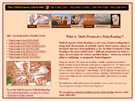 MultiPerspective Palm Reading
MultiPerspective Palm Reading